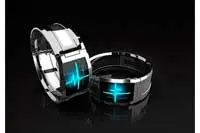Electronics News
Archive : 29 August 2016 год
![]() Researchers from MANA and the Georgia Institute of Technology have jointly developed an anode material for Li-ion rechargeable batteries by forming nanoparticles made of Si-metal composites on metal substrates.
Researchers from MANA and the Georgia Institute of Technology have jointly developed an anode material for Li-ion rechargeable batteries by forming nanoparticles made of Si-metal composites on metal substrates.
The resulting anode material is said to have twice the capacity and a longer life cycle than conventional materials used in Li-ion rechargeable batteries.
However, pure silicon expands three to four times its volume during the process in which Li ion is incorporated into it; as a result, pure silicon anode materials are prone to crack as a large amount of stress is applied to them during repeated charge-discharge cycles.
To counter this, the research group created nanostructured Si-metal composites, using one-dimensional germanium nanowires on metal substrates as a base material layer. The formed nanostructured material has numerous cavities inside clusters of nanoparticles. These cavities act as buffer space to absorb stress generated by the expansion of pure silicon, and by regulating the composition of Si and metal elements in the Si-based nanostructure.
Author
Peggy Lee
Source: www.newelectronics.co.uk
 Edible, non-toxic batteries could one day power ingestible devices for diagnosing and treating disease and a team of researchers from Carnegie Mellon University (CMU) in the United States has reported progress in their development by using melanin pigments, which are naturally found in the body, to develop edible batteries.
Edible, non-toxic batteries could one day power ingestible devices for diagnosing and treating disease and a team of researchers from Carnegie Mellon University (CMU) in the United States has reported progress in their development by using melanin pigments, which are naturally found in the body, to develop edible batteries.
Melanin is a material responsible for the creation of pigments – it is able to absorb ultraviolet light and can also bind and unbind metallic ions. To use it as part of a battery, the team added it to a few other ingredients to create a mix that could be poured onto a steel mesh after adding sodium ions. The battery that resulted, the team found, was capable of discharging for up to five hours, although offering less power than traditional batteries.
"For decades, people have been envisioning that one day, we would have edible electronic devices to diagnose or treat disease," said team member Christopher Bettinger, Ph.D. "But if you want to take a device every day, you have to think about toxicity issues.
"An ingestible, degradable device is in the body for no longer than 20 hours, so even if you have marginal performance, which we currently do, that's all you need."
The team has experimented with battery designs that use melanin pigments at either the positive or negative terminals; various electrode materials such as manganese oxide and sodium titanium phosphate; and cations such as copper and iron that the body uses for normal functioning.
"We found that they work," said Hang-Ah Park, a post-doctoral researcher at CMU. "We can power a 5mW device for up to 18 hours using 600milligrams of active melanin material as a cathode."
Although the capacity of a melanin battery is low relative to a lithium-ion, it should be high enough to power an ingestible drug-delivery or sensing device for delivering bursts of a vaccine over several hours before degrading.
In parallel with the melanin batteries, the team is also making edible batteries with other biomaterials such as pectin, a natural compound derived from plants and used as a gelling agent in jams and jellies.
Author
Peggy Lee
Source: www.newelectronics.co.uk
 A prototype radio from the University of Massachusetts Amherst that allows small mobile devices, such as fitness trackers and smartwatches, to take advantage of battery power in larger devices nearby for communication is currently undergoing testing.
A prototype radio from the University of Massachusetts Amherst that allows small mobile devices, such as fitness trackers and smartwatches, to take advantage of battery power in larger devices nearby for communication is currently undergoing testing.
"We take for granted the ability to offload storage and computation from our relatively limited personal computers to the resource-rich cloud," professor Deepak Ganesan from the University of Massachusetts Amherst explains. "In the same vein, it makes sense that devices should also be able to offload how much power they consume for communication to devices that have more energy. For example, the battery on your smart watch could survive longer by using the higher battery level on your smartphone."
To achieve this, the team at Amherst have embellished Bluetooth, a commonly-used radio technology, with the ability to operate in a similar manner to radio-frequency identification (RFID), which operates asymmetrically – meaning the reader does most of the work and pays the majority of the energy cost of communication, while the tag, embedded in a smaller device or object, is extremely power-efficient.
The technology, named Braidio for ‘braid of radios’, operates like a standard Bluetooth radio when a device has sufficient energy, but operates like RFID when energy is low, offloading energy use to a device with a larger battery when needed. So, when a smartwatch and smartphone are equipped with Braidios, they can work together to proportionally share the energy consumed for communication.
Graduate student, Pan Hu, added that Braidio test results show that when a device with a small battery is transmitting to a device with large battery it can offer roughly 400 times longer battery life than Bluetooth, since the smaller device's battery is preserved longer.
Ganesan said that technologies like Braidio will help to open up a new way of thinking about the design of mobile and wearable devices. "Wearable devices are often bulky due to large batteries needed for adequate battery life," he says. "Perhaps such energy offload techniques can reverse this trend and enable thinner and lighter devices."
Author
Peggy Lee
Source: www.newelectronics.co.uk

